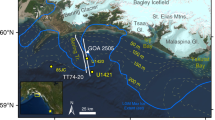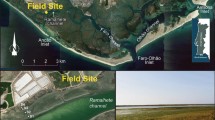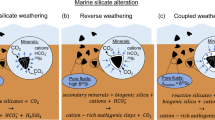Abstract
As little is known about pelagic sedimentation processes in Arctic environments1, the interpretation of biological and chemical processes, as well as the reconstruction of ancient conditions, including those in the glacial North Atlantic, is difficult. Here we provide sediment-trap results, which show that the position of the sea-ice boundary significantly influences the particle flux. The seasonal variability of the particle flux differed markedly in the various sediment-trap sites in Fram Strait, depending on the behaviour of the sea ice. Under complete ice cover, sedimentation is very low, whereas maximum sedimentation is found at the ice margin. The highest particle flux observed, showing a large lithogenic component, was observed at the ice edge where the water was warmer (>2 °C). We find that high biogenic opal fluxes are characteristic of the summer ice margin, indicating that the sedimentary record of opal fluxes may allow the position of ice margins in the past to be reconstructed.
This is a preview of subscription content, access via your institution
Access options
Subscribe to this journal
Receive 51 print issues and online access
$199.00 per year
only $3.90 per issue
Buy this article
- Purchase on Springer Link
- Instant access to full article PDF
Prices may be subject to local taxes which are calculated during checkout
Similar content being viewed by others
References
Honjo, S. in Polar Oceanography (ed. Smith, W. O.) 687–739 (Academic, New York, 1990).
Wefer, G. et al. in Geological History of the Polar Oceans: Arctic versus Antarctic (eds Bleil, U. & Thiede, J.) 363–379 (Kluwer, Dordrecht, 1990).
Berner, H. & Wefer, G. in Geological History of the Polar Oceans: Arctic versus Antarctic (eds Bleil, U. & Thiede, J.) 317–335 (Kluwer, Dordrecht, 1990).
Pfirman, S., Lange, M.A., Wollenburg, I. & Schlosser, P. in Geological History of the Polar Oceans: Arctic versus Antarctic (eds Bleil, U. & Thiede, J.) 187–211 (Kluwer, Dordrecht, 1990).
Smith, W. O. Jr., Baumann, M. E. M., Wilson, D. L. & Aletsee, L. J. geophys. Res. 92, 6777–6786 (1987).
Honjo, S., Manganini, S. J., Karowe, A. & Woodward, B. L. Tech. Rep. WHOI-87-17 (Woods Hole Oceanographic Institution, Woods Hole, 1987).
Honjo, S., Manganini, S. J. & Wefer, G. Deep-Sea Res. 35, 1223–1234 (1988).
Wollenburg, I. & Pfirman, S. Berichte FB Geowissenschaften Univ. Bremen 6, 52–57 (1989).
Fischer, G. et al. Nature 335, 426–428 (1988).
Wadhams, P. in The Nordic Seas (ed. Hurdle, B. G.) 21–78 (Springer, New York, 1986).
Comiso, J. C. & Gordon, A. L. J. geophys. Res. 92, 2819–2833 (1987).
Stabell, B. Geol. Rundsch 75, 175–184 (1986).
Vinje, T. E. Norst Polarinst Arbok 1975 163–174 (1977).
Author information
Authors and Affiliations
Rights and permissions
About this article
Cite this article
Hebbeln, D., Wefer, G. Effects of ice coverage and ice-rafted material on sedimentation in the Fram Strait. Nature 350, 409–411 (1991). https://doi.org/10.1038/350409a0
Received:
Accepted:
Issue Date:
DOI: https://doi.org/10.1038/350409a0
This article is cited by
-
Coastal permafrost was massively eroded during the Bølling-Allerød warm period
Communications Earth & Environment (2023)
-
Marine snow morphology illuminates the evolution of phytoplankton blooms and determines their subsequent vertical export
Nature Communications (2021)
-
Study of 10Be in the sediments from the Krossfjorden and Kongsfjorden Fjord System, Svalbard
Journal of Radioanalytical and Nuclear Chemistry (2014)
-
Paleoceanographic records in the Chukchi Basin, western Arctic Ocean during the late Quaternary
Acta Oceanologica Sinica (2012)
-
Peracarid composition, diversity and species richness in the area of the Northeast Water polynya, East Greenland (Crustacea, Malacostraca)
Polar Biology (2007)
Comments
By submitting a comment you agree to abide by our Terms and Community Guidelines. If you find something abusive or that does not comply with our terms or guidelines please flag it as inappropriate.



